
SUSAN KRASHINSKY ROBERTSON
Aug. 8, 2020
Giancarlo Trimarchi knew his shoppers’ lives had changed during the pandemic. But the cherries really told the tale.
The co-owner of Vince’s Market, an independent grocery store with five locations in Ontario, had already seen sales of fresh produce increase as people began to cook for themselves more often. Then, this year’s crop of sour cherries was ready. Suddenly, people who had more time at home began snapping up the fruit, which is best used for fillings in baked goods or for homemade jam. In all the stores sold 600 pails – roughly triple what they would sell in a typical year.

It’s just one indication of how COVID-19 has disrupted Canadians’ lives – and how they are spending their money, or not. Canada’s labour market has now recovered just over half of the three-million jobs lost during lockdowns related to the virus, Statistics Canada reported on Friday. But that still leaves 2.3-million people who had either lost their jobs or worked less than half their usual hours in July. The pandemic has dealt a shuddering blow to the global economy, which has shaken up normal patterns of consumer behaviour. Sales of makeup and pants are way down; we are investing instead in computers, headphones and cooking supplies.
In Canada, retail sales fell 28 per cent from February to April, sending store chains reeling with little cash on hand to cushion the blow. The list of Canadian retailers that have been pushed into creditor protection is growing longer, and includes brands such as Reitmans, Aldo, Laura, Tristan, Mendocino, Stokes, Frank & Oak, Sail, and the owner of Ricki’s, Cleo and Bootlegger stores. When DavidsTea Inc. obtained creditor protection last month, it had 222 stores; it has now closed all of its U.S. locations and is planning to reopen just 18 in Canada.
Retail sales over all have sharply bounced back from a big drop earlier this year, but industry observers warn that some of the recovery is temporary. Government support programs will eventually be phased out, and an initial rush of pent-up buying is bound to settle down. Looming above all this is the continuing risk of COVID-19 and the potential of further waves of lockdowns.
“We’ve never had a comparable shock to COVID-19,” said Frances Donald, global chief economist with Manulife Investment Management.
And Canadians have entered this crisis with higher household debt levels than at the beginning of the downturn in 2008, said Cliff Grevler, senior partner and managing director of the Boston Consulting Group in Canada. “It is therefore hard to see a quick recovery like we had during the last recession that is led by the Canadian consumer.”
THE NEW ABNORMAL
At Galileo Construction near Montreal, the calls just keep coming.
“COVID-19 has restrained people to their homes – they’re working from home, or they’re not going out or travelling as much,” owner Vince Vilone said. This means homeowners are taking a closer look at the spaces where they are spending so much time. And many are deciding it’s time to renovate. The family-owned firm is now booked up until February. “There are more calls. It’s accelerating as we speak.”
He has noticed that selection from suppliers is more limited for some items, such as bathtubs and faucets.
One customer has scheduled a job for the fall that will include cutting out a new window on one wall, and redoing both the kitchen and the powder room. The client works for a large firm with hundreds of people in a downtown Montreal office building currently working remotely, and is not expecting to go back any time soon.
This is consistent with larger industry trends: as people’s lives have changed, so has their spending.
“Growth drivers continue to be products that help us work and learn at home, or make us more comfortable,” said Armin Begic, executive director of the retail business group at market research firm The NPD Group Inc. In the categories it tracks, 30 per cent of all retail sales growth in June was in work-from-home electronics, such as computers and monitors. Small appliances, especially dishwashers and room air conditioners and fans, grew significantly in June, as did products to keep kids entertained, such as video games.
NPD has also observed people paying more for some of these items, suggesting they are upgrading. The average amount spent on TVs, for example, rose 20 per cent in June compared with April.
“What they may have spent on a vacation, they’re now spending on an upgraded dishwasher,” Mr. Begic said.
At Oshawa, Ont.-based Ultimate Sewing Centre, demand for at-home hobby supplies has been so strong that the waiting list for one sewing machine model is backed up until November.
“Everybody wanted to buy an entry-level sewing machine,” owner Shirley Eichler said. She has sold tens of thousands of metres of elastic to home mask-makers. She is optimistic about what it could mean for the hobby, and is already considering offering more workshops for beginners when she is able to resume in-store classes.
“With the kids being home from school, several of my customers were using that time to teach kids to sew and quilt,” Ms. Eichler said. “…Hopefully that will bring a younger crowd into sewing.”
People are also shopping more from home. In May, online sales more than doubled compared with last year, to $3.9-billion. That still represents just one-tenth of the retail market in Canada, but is a significant boost from the past: In 2019 online sales were 4 per cent of the market.
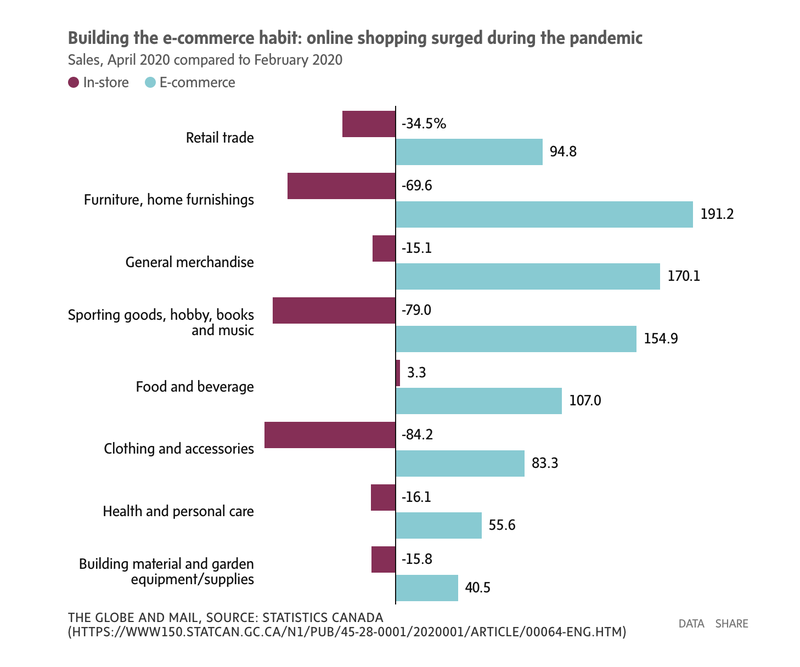
As stores reopen, not all of that online shopping is here to stay, but this new demand is reshaping the industry. Smaller retailers have raced to keep up. Canadian e-commerce giant Shopify Inc. saw a 71-per-cent increase in new stores created on its platform in the second quarter compared with the first.
Vince’s Market was just preparing to move into e-commerce, signing a deal to launch its service with e-commerce delivery company Instacart in June. Then COVID hit.
“Immediately we thought, what can we do in the short term,” said Mr. Trimarchi. The team posted a makeshift order form for customers to fill out online, and staff completed each sale by phone for pickup or delivery. In the first two weeks of April, they processed roughly 1,500 orders. That volume has dropped significantly since the end of May as traffic slowly recovers, but some customers – especially seniors – have now learned to use the service and are sticking with it, Mr. Trimarchi said.
“The younger generation was already used to e-commerce, but we’re going to see many people in older generations using e-commerce far more regularly,” said Dan Kelly, chief executive officer of the Canadian Federation of Independent Business. “We’ve just taken a giant leap.”
And when people do go to the store, they are on a mission.
“Traffic [to stores] is still way down. It’s way down. But when customers come in, our conversion is way up,” Heather Reisman, chief executive officer of Indigo Books & Music Ltd., said on a conference call on Friday to discuss the company’s earnings.
Retailers such as Loblaw Companies Ltd. and Canadian Tire Corp. Ltd. have noted that customers are making fewer trips, but stocking up more on each visit. Both companies have said their ability to offer a one-stop shop for a variety of goods is a strength right now. On Thursday, Canadian Tire reported that its customers’ average basket size grew by 34 per cent in its second quarter.
“Customers are now more than ever looking for a one-stop shopping experience,” chief executive officer Greg Hicks said on an earnings call.
People are also thinking differently about transportation. While auto purchases usually decline during most recessions, according to Manulife’s Ms. Donald, there is evidence that more households are looking at private forms of transportation.
On a typical weekend at Downtown Automotive Group’s dealerships in Toronto, casual shoppers might swing by to browse, kicking tires and sitting behind the wheel of a few floor models. These days, 80 per cent of visits are by appointment, and buyers are motivated. After a month of “non-existent” sales during the shutdowns in April, some locations actually saw growth in June compared with last year. A significant number were first-time buyers.
“We gained some reluctant public-transit riders,” owner Shahin Alizadeh said of his 10 dealerships, which sell a variety of brands including Chrysler, Toyota, Hyundai, Ford. He’s heard the same from other dealers who operate in major urban centres.
At the same time, many customers whose leases were due for renewal have chosen to buy them out rather than having to come to the dealership to trade in for a new vehicle. With new buyers often looking at used cars for their first purchase, the surge in demand and low supply from lease turnovers has led to “almost a critical” contraction in used car inventories.
THE DISCRETIONARY DOLLAR
During the shutdowns this spring designed to impede the spread of the virus, broad swaths of the Canadian economy were suddenly triaged, deemed “non-essential.” But even as stores were permitted to reopen, discretionary spending has taken a hit.
Out of the categories that research firm NPD tracks, the 10 fastest-declining products in June were all clothing, shoes and makeup (Specifically: pants, outerwear, knit shirts, dresses, fashion shoes, woven shirts, jeans, dress shirts, makeup, suits, and fashion sandals). According to Statistics Canada, clothing sales in Canada fell from $2.2-billion in February to $346-million in April and $727-million in May.
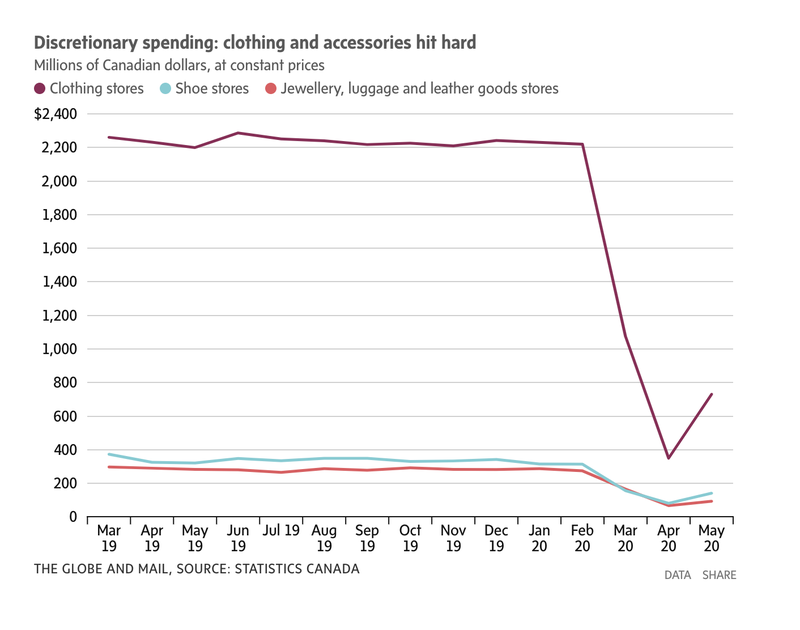
This doesn’t mean the desire to look good has fallen out of fashion permanently: As restrictions lift, some of this spending is beginning to rebound. But discretionary spending is the first budget item to be squeezed as belts tighten. And it’s not recovering yet. While sales improved in many categories in June compared with the previous month, some products such as footwear, clothing and beauty are still down significantly compared with last year, according to NPD.
This may not be just a blip. A recent Statistics Canada survey found that Canadians are planning to cut back most on discretionary spending as the economy reopens.
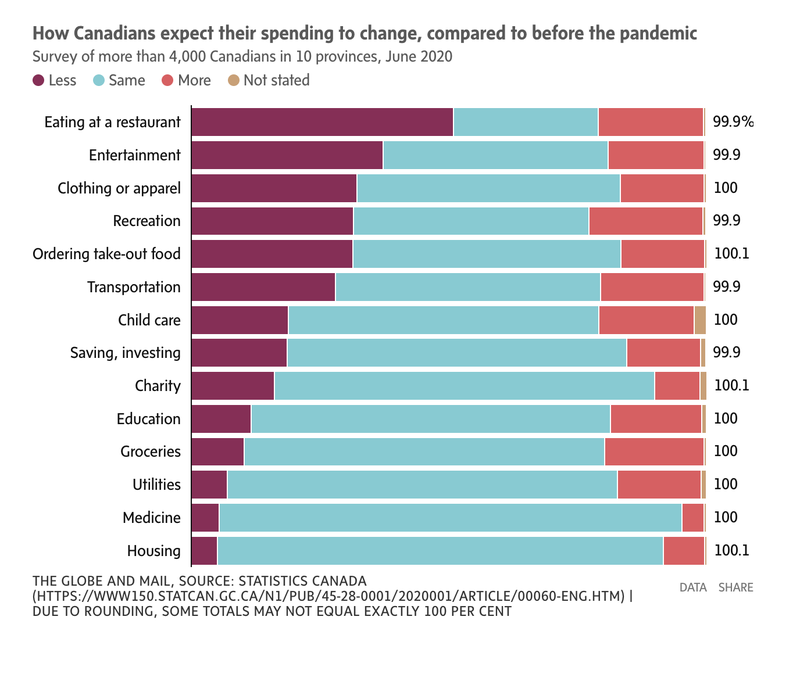
Shara Vigeant, the owner of SVPT Fitness & Athletics in Edmonton, saw some clients cancel training sessions or come in less frequently as they cut costs – in some cases, following a job loss. Even among those who are still spending, priorities have shifted. SVPT has signed on new customers for personal training who were no longer comfortable at their crowded gyms or in group classes.
“I had to hire two new trainers to keep up with the demand,” she said.
Henry’s camera stores were hurt by the decline in big events such as weddings and vacations that often spur people to buy a new camera. But sales of equipment needed for remote work – such as higher-quality webcams – have helped to mitigate the declines, as have hobby-related products.
“Lots of people are taking more walks, or going birding, or starting up a YouTube channel, podcasting. So we’re able to serve those customers,” said Gillian Stein, chief executive of Henry’s Enterprises, the newly-restructured company that owns the stores. “Demand is continuing to increase. But we still have a long road ahead of us.”
THE MORE YOU OWE
Economic shocks often lead to precautionary saving: people who experience a hit to their income become more attuned to the need for a rainy-day fund.
“We have already seen a rise in savings out of COVID,” said Manulife chief economist Frances Donald. “In part that’s because Canadians have been receiving government cheques. But it’s also a standard behaviour from households after they’ve suffered hardship, to think, I want to be prepared for hardship in the future.”
But the ability to save is not equally dispersed. In a June survey from Statistics Canada, nearly one in six people said their income was not enough to cover all their necessities – such as transportation, housing, and food. Of those respondents, 45 per cent said they expect to cut back on saving and investing, compared with 14 per cent of the rest of the population.
A Boston Consulting Group survey of nearly 3,000 Canadians this summer found that people who are paid $1,200 or more per week experienced less loss of income than any of the other income groups. Even so, the highest-paid group reported the sharpest clawbacks in spending, and also reported the biggest increase in budgets directed toward savings or paying off debt.

“The segment of Canadians that are hardest-hit by the COVID-19 recession are also those least capable of saving,” Ms. Donald said. Persistently low interest rates also mean that borrowing is cheap – which could encourage some Canadians to take on even more debt. “I suspect we’re going to see evidence of a shift in the saving-spending mix, but also a further widening of that behaviour between high-income and low-income Canadians.”
Personal budget-management also affects discretionary spending in different ways – and is not always the primary motivator for cutting back. In the BCG survey, 44 per cent said they plan to spend less on restaurant meals than they did before the crisis, even once things return to normal; 39 per cent said they would spend less on clothing and 21 per cent planned to spend less on makeup.
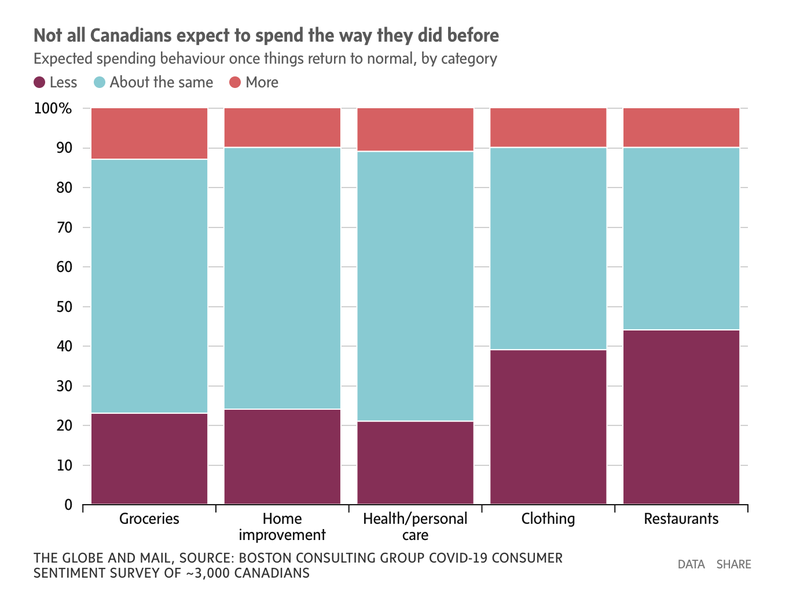
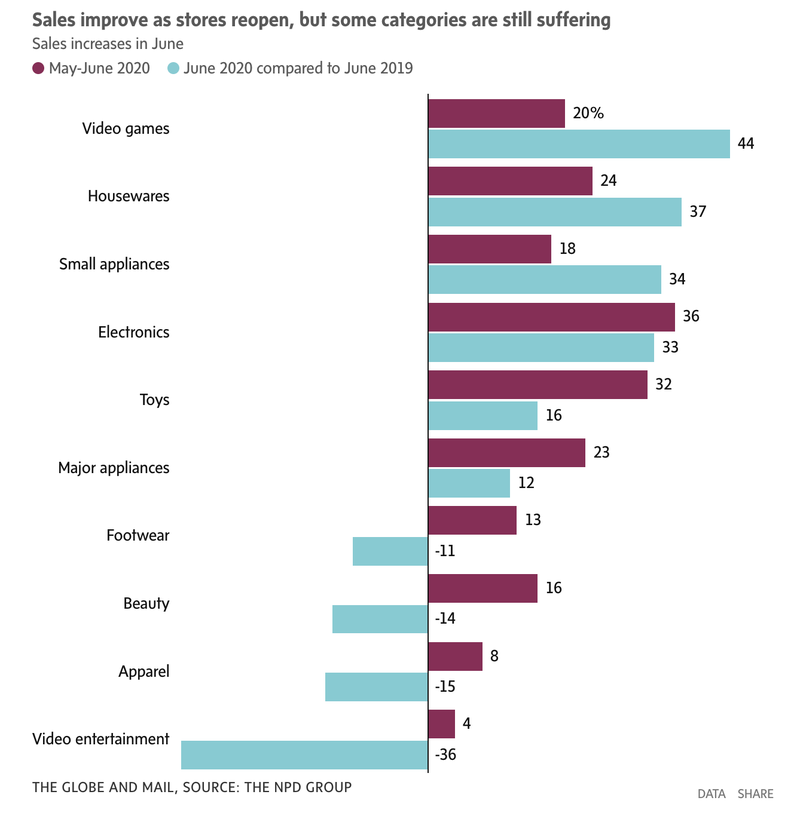
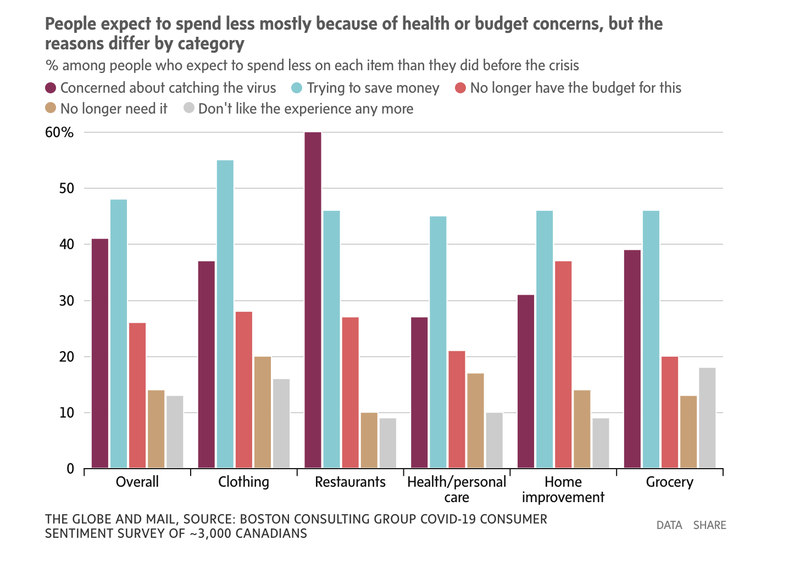
As people do return to spending, they will make different choices about how to allocate those dollars.
“COVID-19 has amplified the trend of de-globalization,” said Manulife’s Ms. Donald. “There has been an emphasis on one’s duty to buy local.”
The owners of Victoire Boutique have seen this firsthand. The business sells clothing and accessories from Canadian designers at its Ottawa store and online across Canada.
“There is more conversation [among shoppers] that we need our dollars to stay local,” said co-owner Katie Frappier, who has noted an uptick in new customers. “Customers that had been on the periphery ... have made that purchase.”
However, Ms. Frappier worries about whether the trend will continue. Most designers had already purchased their fabric for the upcoming fall-winter season before COVID-19 began to affect discretionary purchases such as clothing, and could not cut back on production. Designers will be counting on those sales to make it through this year.
“I have a pit in my stomach thinking about it,” she said. “Lovers of local design have to support it right now. It’s really going to be a gamble, who is able to pull it off.”
THE INCONSPICUOUS CONSUMER
When the dust settles, Canada will be left with a deeply shaken retail environment studded with more vacant storefronts than before the crisis, and a more muted consumer.
BCG’s consumer survey asked people to break down their recent spending patterns, and found that on average, 20 per cent was pent-up demand for things consumers wanted to buy but could not during store closures. A further 10 per cent was either dedicated to needs created by the virus (such as masks or sanitizer) or to spending they planned in the long-term but have moved up (such as home improvements.)
Government aid packages have helped to offset lost employment income and to spur spending, but consumers are still wary of what comes next – since all this government spending has to be made up for at some point down the road.
“There is some longer-term concern that taxes will be rising, given the huge amounts of deficit and debt. And while that may not be true, it’s hard to escape the fact that that’s already permeating consumer psychology,” Manulife’s Ms. Donald said.
Canadians are more pessimistic about the future than many of their global peers. In BCG’s survey, 19 per cent of people said their spending will not return to pre-COVID levels for a year or more; another 22 per cent said their spending may never recover.
“We have not yet been fully impacted by the recessionary impacts of this crisis,” BCG’s Mr. Grevler said. “It will take another few quarters to fully assess the damage.”
At SVPT Fitness in Edmonton, Ms. Vigeant is pleased with the new customers she’s seen, but still wary of what could happen if the economic shock worsens.
“I don’t know if there could be another lockdown, they’re talking about a second wave,” she said. “I’m saving as many pennies as I can because I don’t know what the future holds.”
This Globe and Mail article was legally licensed by AdvisorStream.
© Copyright 2024 The Globe and Mail Inc. All rights reserved.


